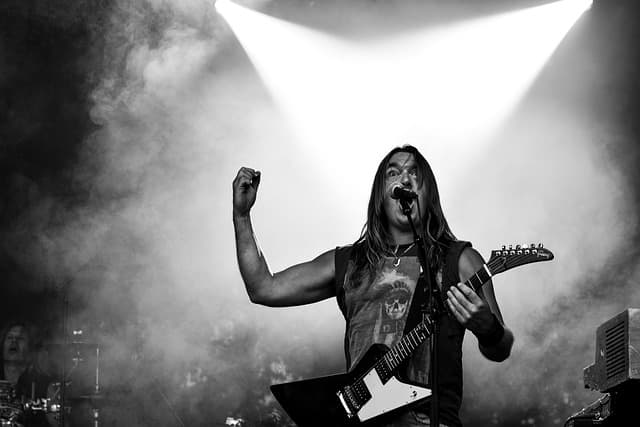Metalcore is a broad musical genre that combines extreme metal and hardcore punk. The name is a word-merger of the names of the two genres that make it up. It is distinguished by its emphasis on breakdowns, that is, slow lapses in the songs, pushing you towards mosh.
Early bands like Hogan’s Heroes, Earth Crisis and Integrity lean more towards punk, while modern bands like Killswitch Engage, Underoath, All That Remains, Trivium, As I Lay Dying, Bullet for My Valentine and The Devil Wears Prada lean more towards metal.
Sepultura, the band that “laid the foundations” of the genre, and Pantera, which influenced Trivium, Atreyu, Bleeding Through and Unearth, are considered influential in the development of metalcore.
Hardcore punk pioneers Black Flag and Bad Brains were fans and recreated the sound of the metal band Black Sabbath in their works. British street-punk bands Discharge and The Exploited were also inspired by metal. The album “Earth A.D./Wolfs Blood” by the hardcore band
The Misfits had a decisive influence on thrash metal. However, punk and metal remained separate currents in the first half of the 1980s, until the crossover thrash scene and its representatives – Corrosion of Conformity, Dirty Rotten Imbeciles, Suicidal Tendencies. This scene influenced representatives of New York hardcore, like Cro-Mags, Murphy’s Law, Agnostic Front, Warzone. In 1986 Bad Brains demonstrated hardcore breakdowns while combining reggae and metal on the album I Against I.
Early Metalcore (1990s)
Between 1989 and 1995 a new wave of hardcore bands emerged. It included the bands Merauder, All Out War, Integrity, Biohazard, Earth Crisis, Converge, Shai Hulud, Starkweather, Judge, Strife, Rorschach, Vision of Disorder and Hatebreed.
Vocals
Typically, a scream is used as the primary vocal style. This was especially noticeable among the bands of the 1990s. Nowadays, most of the bands add choruses or even verses, sung with “clean” vocals, to the scream. In many ways, this manner came about because of the influence of emo on the genre.
Music
Speedy guitar riffs and the use of gimbal or double bass drumming are staples in metalcore. Guitars’ scale is usually lowered, Drop D, Drop C, Drop B are used. On the drums it is often possible to hear the technique of blast beats.
Ideology
Since initially the scene of metalcore was formed around hardcore punk, then the roots of the ideology of metalcore are in this genre. Mainly artists from hardcore-punk took ideology of straight age, but there were some exceptions like Integrity and Converge. Converge based their lyrics on personal experiences and failed love. Integrity frontman David Helion proclaimed the “Church of the Holy Terror of the Last Judgement”, which he took from the Cathar and Gnostic systems. At the same time, Christianity is very common in metalcore. Many members of famous bands position themselves as religious Christians, for example: the members of Zao, The Devil Wears Prada, As I Lay Dying, August Burns Red, Texas in July, Demon Hunter, Oh, Sleeper and Underoath.
Matcore
Matcore emerged in the mid-1990s with the work of such bands as Converge, Botch and The Dillinger Escape Plan. The term itself was coined by analogy with mat-rock. Matkor is characterized by high speed, technicality of performance and unusual rhythm. Some bands, such as Fear Before, for example, add a lot of progressive elements to their music.
Melodic Metalcore
At the beginning of 1990 the third wave of metalcore bands began to form. These bands distinctive feature was much more melodic composition and close relationship with post-hardcore bands. The main basis for this was the mixing of metalcore with melodic death metal, mostly of the Swedish scene like bands like At the Gates, Arch Enemy, In Flames and Soilwork, and in some cases emo. The leading bands of this wave are As I Lay Dying, Trivium, All That Remains, Atreyu, Bullet for My Valentine, Darkest Hour, Eighteen Visions, Killswitch Engage and Poison the Well. Due to the wide popularity of these bands, metalcore entered into the mainstream as a genre, so at the moment the term is understood as the third wave of the genre. Most of the bands of melodic metalcore perform the main vocal parts with clean vocals. According to an article in Revolver magazine, melodic metalcore is an infusion of typical 80’s metal clichés into modern hardcore.
Deathcore
With the growth of metalcore popularity, some lines of the latter have penetrated into death metal. The bands Suicide Silence, Carnifex, Salt the Wound and Job for a Cowboy combined metalcore and death metal. This subgenre combines speed drums (including blast beats), low-tuned guitars, tremolo and growling from death metal with screaming, melodic riffs and breakdowns from metalcore. According to Decibel magazine, Suffocation’s work was the basis for the emergence of deathcore.

